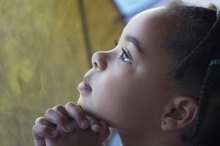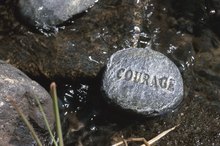What Can Kids Do to Promote Peace?
It would be wonderful if your child lived in a world where children weren't exposed to bullying, violence and abuse, but don't sit back and accept that the world often is not a peaceful place. Instead, help your child learn to show small gestures of peace that can add up to a big difference in her family, school and community.
Random Acts
Teach your child to perform random acts of kindness. Encourage her to smile at others, say nice things to friends and siblings, and to write notes to teachers and grandparents. Once your child is comfortable performing acts of kindness toward people she knows, challenge her to think about strangers, too. Encourage your child to invite a new friend at school to come play with her or to tell the school janitor thank you when he replaces the paper towels or cleans up a mess in her classroom. When you teach your child to show gratitude and love, you're also teaching her to make every effort to live harmoniously with others.
- Teach your child to perform random acts of kindness.
- Once your child is comfortable performing acts of kindness toward people she knows, challenge her to think about strangers, too.
Stand Up Against Bullying
Long Term Effects of Yelling at Children
Learn More
Talk to your child about bullying and children being mean to each other. Remind your child that you expect him to be kind to everyone around him and to keep mean words and actions to himself. Promote peace even more by challenging him to be on the lookout for bullying. If he sees a friend or classmate being bullied or picked on, he can act peacefully by standing up for the victim or by telling an adult who can help. Demonstrate this behavior by taking actions such as standing up for a store employee who's getting yelled at by a customer. Kids learn by example, according to the National Association of School Psychologists, and setting a good example is powerful way to promote peace 1.
- Talk to your child about bullying and children being mean to each other.
- If he sees a friend or classmate being bullied or picked on, he can act peacefully by standing up for the victim or by telling an adult who can help.
Help Those In Need
Help your child get involved in the community. Perhaps she could volunteer to read to smaller children at the library or serve food at a homeless shelter. Serving others can help children learn that the world has all types of people and that no one is better than anyone else. Allow your child to find a friend or sibling to volunteer with her. According to Nathan Otto and Amber Lupton, authors of "Give Peace A Deadline," when humans work together toward a common goal, they're more likely to enjoy it, and make a difference in their community 2.
- Help your child get involved in the community.
- According to Nathan Otto and Amber Lupton, authors of "Give Peace A Deadline," when humans work together toward a common goal, they're more likely to enjoy it, and make a difference in their community 2.
Teach Conflict Resolution
How to Teach Kids How to Introduce Themselves to Others
Learn More
Helping your child learn how to solve his own problems is an effective way to promote peace because it teaches him how to function in the real world and how to compromise to retain relationships. According to the National Association of School Psychologists, allowing children to use violence to solve their problems builds hate and a lack of tolerance 1. When that occurs during childhood, children are more likely to grow up still relying on violence to solve their problems. Role-play with your child so he can practice using appropriate words and learn acceptable ways to treat others.
- Helping your child learn how to solve his own problems is an effective way to promote peace because it teaches him how to function in the real world and how to compromise to retain relationships.
- Role-play with your child so he can practice using appropriate words and learn acceptable ways to treat others.
Related Articles
References
Writer Bio
Sara Ipatenco has taught writing, health and nutrition. She started writing in 2007 and has been published in Teaching Tolerance magazine. Ipatenco holds a bachelor's degree and a master's degree in education, both from the University of Denver.









